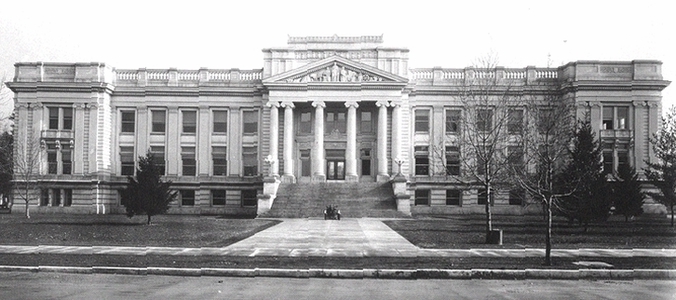PROVO

Provo City and County Building
Situated in the heart of Utah Valley between the east shore of Utah Lake and the towering Wasatch Mountains is the city of Provo. Mount Timpanogos (elevation 11,957 feet) dominates the northern view from the city. Other rugged mountains east of the city provide one of the most picturesque backdrops for a Utah city.
Utah Valley was the traditional home of Ute Indians, who settled in villages close to the lake both for protection from bellicose tribes to the northeast and to be close to their primary source of food--fish from the lake. The first white visitors to the Provo area were Fray Francisco Atanasio Dominguez and Fray Silvestre Velez de Escalante, who visited Utah Valley in 1776. Only a retrenchment in Spanish New World colonization and missionary efforts prevented establishment of settlements promised by these Franciscan missionaries.
Fur trappers and traders frequented the area in the early decades of the nineteenth century, and it is from one of these trappers, Etienne Provost, that Provo takes its name.
Provo was settled by Mormons in 1849, and was the first Mormon colony in Utah outside of Salt Lake Valley. Troubles with Indians gave rise to a popular saying in early Utah: "Provo or hell!" When President James Buchanan sent United States troops to Salt Lake City to put down the "Mormon insurrection" in 1858, thousands of Mormons, including leader Brigham Young, moved to Provo. "The Move South" came to a quick end as the Mormons were "pardoned" and new governor Alfred Cumming made peace with the Saints.
Provo remained the second largest city in Utah until Ogden became Utah's primary railroad terminus in 1869. Provo lost in its bid as a transcontinental railroad stopping place, but thereby retained its distinctly Mormon flavor. It soon came to be known as the "Garden City" because of its extensive fruit orchards, trees, and gardens.
In 1875 Brigham Young Academy was founded. From humble beginnings, this institution has grown into Brigham Young University, the largest church-affiliated university in the United States today. The city and the university have enjoyed a symbiotic relationship and have grown together. Today, the university has helped generate a fledgling high-technology industry in the Provo area and sometimes attracts national attention through its academic and sports programs.
Historically, Provo has served as the focal point of Utah Valley industry, commerce, and government. Agriculture and the Provo Woolen Mills (which had its origin in the Mormon cooperative movement of the late 1860s) served as Provo's commercial staples in the late nineteenth century. Mining magnates such as Jesse Knight, made rich by nearby precious-metal mines, made their homes in Provo and helped create a thriving financial industry in the city. The coincidence of a major water source and the intersection of two railroad lines led to the completion in the Provo area of the Ironton steel mill in the early 1920s and later the much larger Geneva steel plant. The railroads brought in needed raw materials and transported finished steel products from Provo. Area residents currently argue about whether the Geneva plant, which many assert is a major cause of Provo's serious air pollution problems, should continue to be operated or whether Provo should rely on new high technology as its industrial base. As county seat of Utah County, Provo is the home of county offices and courts. Since the mid-1880s Provo has been the home of the State Hospital, originally the Territorial Insane Asylum.
Because of its close proximity to the mountains, Utah Lake, and rivers, Provo residents have many recreational outlets. In winter, alpine and cross-country skiing, ice skating, and other winter sports are available within minutes. In summer, hiking, camping, fishing, and boating are equally accessible.
Provo residents have long been proud of their city. Supreme Court Justice George Sutherland, United States senators Reed Smoot (who also served as an apostle in the LDS Church) and William King; LDS Church apostle Dallin Oaks (who also served as president of Brigham Young University and as a justice of the Utah Supreme Court); Jack Dempsey, former heavyweight champion of the world, and numerous less well-known political, church, sports, and business figures have lived in Provo.
Today, Provo is a thriving community of 86,835 (1990 census). The city's downtown heart is no larger the center of Utah Valley commerce, having lost that honor to large suburban shopping malls. Provo's once proud train depot was recently demolished, a symbol of the declining importance of passenger rail transportation in the West. Provo's downtown area remains, however, the focal point of Utah Valley political life, and nearby Brigham Young University remains the education center of the area. Provo has grown from a quiet, small Mormon city to a substantial modern metropolitan area. Some of its traditional quaintness is gone, but its heart and soul continue to thrive.
Disclaimer: Information on this site was converted from a hard cover book published by University of Utah Press in 1994. Any errors should be directed towards the University of Utah Press.